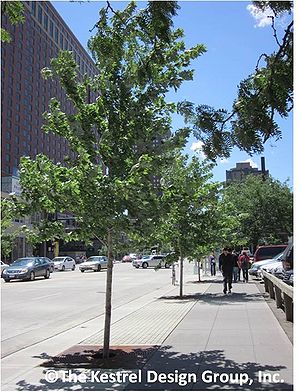| Residential rain garden (Courtesy - Katherine McLellan) |
We once received a comment asking why we didn’t have
information on rain gardens in the Minnesota Stormwater Manual. Of course,
there is an entire section
in the manual on bioretention, but it didn’t occur to us that people didn’t
know a rain garden is a bioretention practice. Surprisingly, when it comes to
bioretention (rain gardens), we find that some people struggle with the
terminology. This post hopefully clarifies some of that terminology.
First off, a rain garden is a bioretention practice, or best
management practice (BMP). Bioretention practices are shallow depressions designed
to capture stormwater runoff and remove pollutants from the runoff. All
bioretention practices employ vegetation and engineered media or soil to aid in
the treatment process.
There are two basic types of bioretention practices. The
first is bioinfiltration, in which the stormwater runoff entering the practice
infiltrates through the engineered media and into the underlying soil. The
second type of bioretention practice, called biofiltration, has a pipe called
an underdrain below the surface of the engineered media. The underdrain
intercepts water that is percolating downward and returns it to the storm sewer
system. Both bioinfiltration and biofiltration practices remove pollutants from
stormwater runoff through filtering, adsorption, and plant uptake as the runoff
percolates through the media. However, biofiltration practices are necessary
when we can’t or don’t want to infiltrate the water into the underlying soil.
This might be the case when soil infiltration rates are low, when bedrock is
close to the bottom of the bioretention practice, or when the underlying soils
are contaminated and we don’t want to mobilize contaminants.
There are variations of biofiltration practices. We may raise the underdrain above the bottom
of the engineered media to allow for some infiltration, place the underdrain at
the bottom of the media to limit infiltration, or line the bottom of the
practice to prevent any infiltration.
| Fate of stormwater runoff (red) in bioinfiltration (left) and biofiltration (right) practices. |
Because bioretention practices are vegetated, it is critical
to limit the depth of water stored in the practice and ensure the water drains
within 48 hours or less. The vegetation must be carefully selected because
there are periods of water inundation and drought within the practice. Unfortunately,
the Minnesota Stormwater Manual contains only scattered information on this
topic. Suggested references include the following:
- Minnesota Stormwater Manual - Bioretention landscaping
- Minnesota Stormwater Manual – Plant lists
- Plants for Stormwater Design (Shaw and Schmidt, 2003) and Vol. II (Shaw et al.)
- University of Nebraska – Lincoln; Extension. Nebraska Bioretention and Rain Garden Plants Guide (for purchase)
 |
| Tree BMPs on Marquette Avenue |
While there are many other references on vegetation
selection, establishment, and maintenance, it is important to find information
applicable to Minnesota.
Tree-based stormwater practices, such as tree trenches and
tree boxes, are also bioretention practices. They are designed somewhat
different than typical rain gardens though. Two important differences from
typical rain gardens are that stormwater runoff is usually held within the
engineered media instead of ponded within the practice, and the media volume is
often greater to accommodate tree growth. For more information see the
appropriate section
on tree-based practices in the Minnesota Stormwater Manual.
Finally, there are differences between bioinfiltration
practices and other infiltration practices, such as infiltration trenches,
infiltration basins, and underground infiltration. This can all get confusing,
but the following bullets summarize the major differences.
- Infiltration (basin, trench, underground) – often used for regional stormwater control; up to 50 acres in size; ponding depth can be several feet
- Bioinfiltration – typically used for local stormwater control; 5 acres or less in size; ponding depth less than 18 inches to allow for vegetation growth
- Biofiltration – same as bioinfiltration except has an underdrain
- Bioretention – includes bioinfiltration and biofiltration practices. Also called rain gardens. Tree-based systems, such as tree trenches and tree boxes, are a form of bioretention.